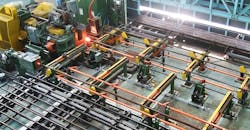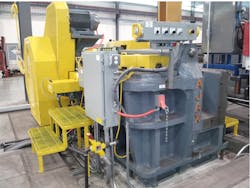Automatic Drive for Forging Machinery
Global industrialization owes a debt to forging equipment operators: Without forgings, over the past 150 years, manufacturers would not have had the components needed to manufacture cars or aircraft, or to drill for oil, mine for minerals, or to build railroads, ships, and other standard equipment and structures. However, as with any process involving manual labor, automation is changing the game.
Despite lagging behind many other industries, forgers increasingly require significant automation upgrades for new equipment and remanufactured/rebuilt models of everything from horizontal forging machines and vertical presses, to hammers, and solid ball die forgers.
As a result, manufacturing steps that once were performed manually—such as moving heavy steel rods, pipe, and other stock in and out of processing—now are automated to improve worker safety and expand performance efficiency. We’re well past the time when three men would place a heavy steel rod with a glowing end into a horizontal upset forging press, position it for forming, and then removing the part after it’s been formed before starting again.
Today, many manual forging tasks have been replaced with the mechanical “hand” of a robot, or by integrating servos that can lift, insert, and deposit materials. Even tasks like automated tooling changes can be completed with the push of a button.
Not only does this create a safer environment for operators, but productivity is increased. By automating forging operations to perform some of the tasks of a human operator, productivity can increase from several hundred pieces per hour to up to 3,000, depending on the type of products being forged.
“About 90% of the time we talk to customers today, they want equipment that has an automation component,” according to Ken Copeland, president of Ajax-CECO, one of the oldest manufacturers of forging equipment.
Having begun operations in 1875 Ajax-CECO has built and put into production more than 6,000 horizontal and vertical forging presses. In 2005, it purchased the intellectual property of the Chambersburg Engineering Co. (hammer, impact, and wheel press machinery), and now manufactures and supports both brands of equipment.
According to Copeland, most of the automation requests are for control consoles or some type of material handling and conveying equipment to bring the steel or other materials into the machine, position it as needed for heating and forging, then finally placing the finished item into a bin. In the most advanced cases, entire forging line “cells” can be created with sophisticated communications that report production rates and machine performance back to company networks. This demand, Copeland added, applies to both new and existing forging equipment.
“It is not uncommon for a customer that has, or acquires, an older model of equipment to send it to us to be rebuilt or remanufactured while adding automation upgrades to it,” he said.
Modern Forge Tennessee is one example. A hot forging operation making steel parts for Harley Davidson among other customers, Modern Forge uses Chambersburg (CECO) die forgers that date back to the 1980s and weigh between 20 and 50 tons. It has more than 7,000 forging dies in its inventory.
To continue to leverage its investment in existing equipment, Modern Forge decided to update and upgrade the consoles on its drop hammers to improve performance, in view of the fact that these machines run hard and at very tight tolerances. “We had some very good hammer units with some very outdated controls,” according to Wade Ferguson, Modern Forge maintenance manager. “We knew that if any of the parts in the consoles went down we would be offline for a while.”
Aware that the intellectual property of Chambersburg Engineering had been purchased by the, Ferguson approached the new IP holder for the automation upgrade. “Ajax-CECO was able to build the new panels, create the necessary software to run it, and calibrate it all to our specific needs,” Ferguson said.
He added that later this year Modern Forge of Tennessee also may be installing a robot on its trim press, to handle production delays impacting the quality of the trim removal.
After observing operators to determine how much time is needed to trim each part, Ajax-CECO were able to determine that when the workers got tired the work would slow considerably, and they would get behind. When too much time passed between parts, the platters would cool off enough that trimming became difficult.
After the revision, when the hammer operator completes the forging the robot will pick up the item and trim it, promptly, and consistently each time.
“Forging companies like ours are increasingly considering how to automate our presses, to help our operators,” said Ferguson. “There is only so much an operator can do. With automation, robots, and other motorized devices can move the part through the various stages of the process with more speed, safety, and accuracy.”
The Eaton Corp. forging operation in Kearney, NE, operates 26 Ajax-CECO forging presses, ranging in size from 100 to 1300-ton capacity. Eaton is one of the top producers of forged engine valves and precision gears for the North American automotive supply chain. The Kearney facility also manufactures precision-forged parts for agriculture, marine, ATVs, automotive, and heavy-duty machinery.
As part of a two-stage process for creating its engine valves, a round steel slug is formed into an “onion-head” shape using a die press. Then, the workpiece is transferred to a re-strike die where it is formed into the final product. For many years the transfer from the first to the second stage of the process was performed manually, by an operator at the machine.
Approximately four years ago, Eaton undertook a project to automate the process so that the operator needs only to push a button and a robotic arm completes the transfer. The upgrade was applied to 15 of the Ajax-CECO presses used specifically to produce the engine valves. The driver for automating the process was worker safety, according to Randy Kreutzer, lead maintenance manager at Eaton.
“You have a person sitting in front of a press who, theoretically, could be injured if something went wrong,” explained Kreutzer. “Now, we have them out of that scenario. They’re still there, but they are behind protective shields and only there in case adjustments need to made.”
Kreutzer added that there was a benefit to increased productivity as well, because it allows Eaton to run two presses instead of just one. “We are constantly updating our equipment,” he said. “The industry is moving past the mentality of having a man or a woman do all the manual labor, and instead letting technology take over. That’s the drive in the industry right now.”

